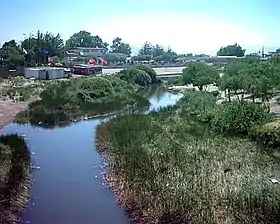Ecorregión de agua dulce Atacama
La ecorregión de agua dulce Atacama (338) es una georregión ecológica acuática continental situada en el centro-oeste de América del Sur. Se la incluye en la ecozona Neotropical.[1][2][3][4][5][6][7][8][9]
| Ecorregión de agua dulce Atacama | ||
|---|---|---|
 | ||
| Ecozona: | Neotropical | |
| Países |
| |
| Ecorregiones – WWF | ||
Distribución
Se distribuye en el sudoeste de Bolivia, el norte de Chile, y el sur del Perú. Su nombre refiere al desierto de Atacama, el más árido del mundo, sobre el cual discurren los cuerpos de agua correspondientes a esta ecorregión de agua dulce. Incluye a los ríos: Camarones, Caplina, Codpa, Copiapó, Loa, Lluta, y Sama. También cubre numerosos salares y lagos salados, entre los que destacan el de Pintados, el Grande, el de Llamará, el de Miraje, el de Navidad, y el de Atacama.
Referencias
- Clarke, J. D. A. (2006). "Antiquity of aridity in the Chilean Atacama Desert" Geomorphology 76(2006) 101-114.
- Dyer, B. S. (2000). "Systematic review and biogeography of the freshwater fishes of Chile" Estudos Oceanologicos 19 77-98.
- Hijmans, R. J., S. Cameron and Parra., J. (2004) "WorldClim, Version 1.4 (release 3). A square kilometer resolution database of global terrestrial surface climate " <>(40010)
- Moreno, T. and Gibbons, W. (2007). "The geology of Chile" Bath, UK: The Geological Society.
- Rech, J. A., Pigati, J. S., Quade, J., et al. (2003). "Re-evaluation of mid-Holocene deposits at Quebrada Puripica, northern Chile" Palaeogeography, Palaeoclimatology, Palaeoecology 194(2003) 207-222.
- Reis, R. E., Kullander, S. O. and Ferraris, C. J., Jr. (Ed.) (2003). "Check List of the Freshwater Fishes of South and Central America" Porto Alegre, RS: Edipucrs.
- Santoro, C. M., Arriaza, B. T., Standen, V. G., et al. (2005)"People of the coastal Atacama Desert: living between sand dunes and waves of the Pacific Ocean" In P. Veth, M. Smith and P. Hiscock (Ed.). Desert peoples: archeological perspectives. (pp. 243-260) Malden, MA, USA: Blackwell Publishing.
- Wetlands International (2005) "Ramsar Sites Database: A directory of wetlands of international importance" <http://www.wetlands.org>(40217)
- World Wildlife Fund (WWF) (2001) "Terrestrial Ecoregions of the World" <http://www.worldwildlife.org/wildworld/profiles/terrestrial_nt.html>
Este artículo ha sido escrito por Wikipedia. El texto está disponible bajo la licencia Creative Commons - Atribución - CompartirIgual. Pueden aplicarse cláusulas adicionales a los archivos multimedia.